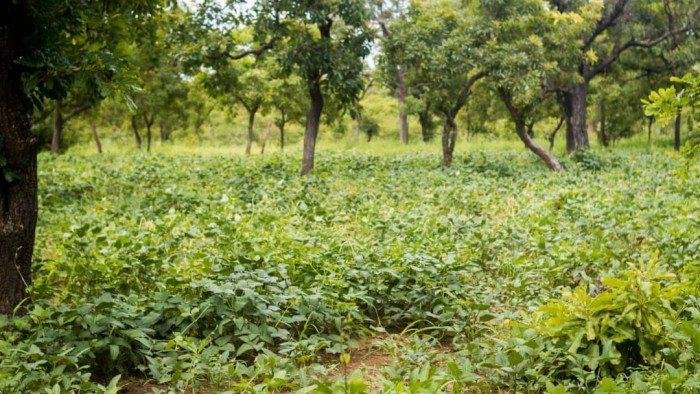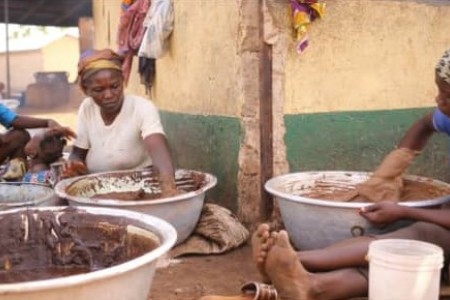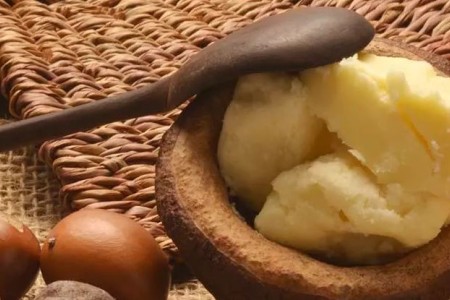Can a Partnership Bury Carbon and Elevate Equity in Ghana?

In Brief
Shea butter farming can drive living standards and business prospects in Ghana.
A project to replenish savannas also aims to erase red tape that blocks women from building farming businesses.
Our reporter talks to project sponsors and regulators to spell out hopes, metrics, and lessons flowing into and out of this effort.
In Ghana, forests rich in gold, timber, and other products back a mainly agrarian economy, but in recent times forest cover faces an annual loss of 2 percent as poachers, miners, farmers, and wildfires crowd into this landscape. A new project aims to reverse this forest loss, honor Ghana’s global climate commitments, and empower women in the production of shea butter among other activities.
The Ghana Shea Landscape Emission Reduction Project (GSLERP) seeks to restore degraded savannah forests and strengthen livelihoods – with women as focal beneficiaries - expecting to positively impact 15% of the Northern Savannah Zone (NSZ) population and deliver 6.139 million tCO2e in emission reductions and removals over the first seven years of the project’s lifetime and 25.24 million tCO2e over 20 years through enhanced ecosystem services. This will be achieved through the restoration of 200,000 hectares of off-reserve savannah forests/woodlands by placing them under collaborative sustainable natural resource management mechanisms known as Community Resource Management Areas (CREMA). These target 100,000 hectares of degraded shea parklands and the creation of 25,500 hectares of modified forest in now severely degraded reserves.
The Ministry of Lands and Natural Resources (MLNR), the parent ministry for the Forestry Commission, leads on policy reforms including tree tenure and benefit-sharing to support the CREMAs. Shea tree seedlings will be raised by regional district offices of the Forestry Commission for enrichment and plantation development within forest reserves. Community members within the participating CREMAs will be trained and receive seedlings and technical assistance for nursery management from the Forestry Commission’s Forest Services Division (FSD) and Wildlife Division. Kwame Nkrumah University of Science and Technology (KNUST) will provide the service of project knowledge management, and the Forest Research Institute of Ghana (FORIG) will undertake applied research on the project activities. The success of domesticating the shea propagation and bringing it closer to residences of community members and on farms will increase their interest in preserving the trees and undertaking replanting activities. It can increase the income of an estimated 20,000 women shea nut collectors by 30%-50% and even much more along the entire value chain.
With these interventions and support, the women shea nut collectors will be able to re-stock an estimated 1.75 million trees in shea parklands with higher and quicker yielding varieties of shea to ensure future supply, aggregation, and direct marketing through performance-based contracts that exist between members of the Global Shea Alliance – which includes Bunge Loders Croklaan, Wilmar International, the Ghana Nuts Company Ltd., and other brands and retailers that market products containing shea butter to consumers. The alliance also includes women’s groups, some of whom are organized and led by traditional authorities such as queen mothers, affluent local shea butter businesswomen, local champions and religious bodies in the rural communities. The expected income streams that will be created throughout the project (through facilitating aggregation and wood-related cost savings) for the women collectors are estimated at $3,150,000. Co-benefits will include an increase in gender inclusion, with women enhancing their business skills through capacity building workshops that will further improve their access to socio-economic benefits and finance from their engagement in the shea supply and value chain.
The alliance also includes women’s groups, some of whom are organized and led by traditional authorities such as queen mothers, affluent local shea butter businesswomen, local champions, and religious bodies in the rural communities.
Efforts made through the Ghana Shea Landscape Emission Reduction Project – with US$30.1m funding from the Green Climate Fund and other counterpart funding to the tune of a total of over US$54m - are traced to Ghana’s international climate change commitments. Based on the nation’s current circumstances, its Nationally Determined Contributions (Gh-NDCs), using the Ghana National REDD+ Strategy, is centered on adaptation and mitigation actions expected to help in attaining low carbon climate resilience and greenhouse gas (GHG) emission reduction in seven priority (Gh-NDC) implementation areas within the next ten years (2020-2030).
The Northern Savannah Zone (NSZ) has an expanse of 9.7 million hectares, populated with over 5.5 million people and with three of Ghana’s poorest regions – the Northern, Upper East, and Upper West regions - is faced with threats of forest cover decline with already experienced over 77% loss between 2001 and 2015. Significant annual forest loss can be attributed to the conversion of woodland to grassland and then to pasture. Shea landscapes, with their carbon sequestration potential, dominate the NSZ and improve the adaptive and resilient capacities of their ecosystems. Shea trees are perennial and bear abundant crops during much of their lifetime - close to 100,000 tonnes of harvest - generating approximately $175m (cum. 2016) in national revenue annually.
Women are identified as major actors in the shea value chain, playing key roles as producers and processors because, by tradition, they are excluded from land access but allowed access to shea parklands to collect and utilize the shea fruits and nuts. The shea business is acknowledged in the NSZ as a women’s business in the main. Harvesting and collecting shea nuts is a key source of livelihood in supporting over 90% of women in the NSZ. Shea also represents between 12% to 32% of household income and its by-products such as soap, cosmetics, and fuel provide important additional sources of income. Efforts of these women are majorly limited by lack of access to investment capital, cutting down of live shea trees by illegal chainsaw operators, bushfires, lack of modern processing equipment and training; and poor pricing of shea products in the local market.
“Ghana’s REDD+ Strategy and its Forest Reference Level brings to light the environmental crisis of the NSZ and seeks to address it through sustainable land use and equitable social development,” explains Ms. Rosalyn Fosuah Adjei, Director of the Climate Change Directorate of the Forestry Commission.
As the world’s largest fund dedicated to helping developing countries fight climate change through the channeling of climate finance, the Green Climate Fund (GCF) is the financer of this project and manages the project’s portfolio through the UNDP as the accredited entity. Project funding totals US$ 54.4m - US$30.1m grant from GCF and 44.8% from the Ghanaian government and private entities such as the Global Shea Alliance. The Forestry Commission is the implementing partner and receives technical support from the Global Shea Alliance alongside multiple national and local governing institutions.
“It’s the first time that shea parklands are being considered in Ghana for a REDD+ initiative and it will encourage various communities of the NSZ as well as within the sub-region to integrate natural resource management into their land use, giving them a collective sense of purpose,” says Mr. Charles Sarpong Duah, Manager at the Climate Change Directorate of the Forestry Commission.
The project’s Environmental and Social Management Framework (ESMF) explicates its outputs and extensive stakeholder engagement approaches in involving ten ethnicities - the Kasena (Grusi), Sisaala, Builsa, Mamprosi, Kantosi, Komma, Wala, Dagaaba, Chakali, and Nankana who will be engaged through their distinctive community leadership structure made of chiefs, clan heads, and family heads. An overarching principle of this project is respect for human rights – recognizing marginalized populations, women, and ethnic minorities.
Capacity building, knowledge management, business and enterprise development, and other training for participating communities are integral to this project. The success of these initiatives will be determined through surveys run by the project team and is expected to reflect stakeholder satisfaction and their ability to reproduce skills and knowledge acquired in managing their farmlands, resources, and shea business. Two distinct phases will facilitate success in stakeholder engagements and community activities. The inception phase is ongoing and workshops are being held with key stakeholders to develop an annual plan and project schedule in line with the approved project design. In the first six months of the project – after its approval in August 2020 – contact with stakeholders will be made to identify all actors and beneficiaries. The rules of engagement regarding gender and minority groups will also be disclosed to build consensus. The implementation phase, once initial funds are disbursed, will also engage key stakeholders to review implementation processes of expected outputs and will continuously identify and address project shortfalls to improve performance. A schedule outlining activity, their dates, periodicity, and locations where various stakeholder engagements will occur, including consultations, disclosures, and partnerships will be agreed upon amongst stakeholders and drafted by the Forestry Commission.
The GSLERP’s implementation arrangement is built on lessons from the success of Ghana’s Cocoa Forest REDD+ Program implemented in 2019 – using the community engagement concept and CREMA’s. Its sub-project, the Partnership for Productivity, Protection and Resilience in Cocoa Landscapes (PPPRCL), catalyzes investment from the private sector - with the involvement of organizations such as Touton and SNV – that ensures all stakeholders across the cocoa sector commit to and collaborate on achieving Climate Smart Cocoa which is tied to Ghana’s Emission Reduction Programme. A robust and cost-effective deforestation monitoring system using GIS has also been established to help curb struggles faced by these stakeholders in demonstrating a measurable reduction in deforestation in their supply chains. Successfully, the implementation has also gone further to create super governance through the creation of hotspot intervention areas – gathering more CREMAs in a landscape to achieve forest conservation. The GSLERP is set on a road of success as implementation concepts have proven to be replicable and scalable.
Considerations have been given to the possibility of some marginalized and vulnerable people – particularly women – being unintentionally excluded from project activities due to cultural barriers hence project support staff and stakeholders will be trained on managing such gender-related issues. Also, a gender and safeguards officer will be a part of the project management team to ensure that the potential for the marginalization of community members and pastoral tribes are unrecognized.
The UNDP Supplemental Guidance on Grievance Redress Mechanism will serve as a guide for the project-level Grievance Redress Mechanism (GRM) to manage conflicts that may arise among communities and individuals such as middlemen who are likely to run at a loss as women become empowered to engage in direct marketing and sale of shea. Due to past experiences, some farmers may distrust project actors. In times past, other private actors that have shown interest and embarked on restoration projects in the NSZ failed to identify that, as some zoned land had already been designated for different purposes due to traditional practices or policies and required further action to reconcile optimal land use through adequate stakeholder engagement. In moving from open-access to strong community management of lands, community members are likely to lose access to such resources hence the project’s governance arrangements on community consultations and consent will follow the required rural guidelines to ensure that trust is maintained. The project will model its GRM structure and processes under the authority and traditional jurisdiction of designated traditional authorities (chiefs and queen mothers), and with the support of highly respected individuals of good ethical and moral standing, religious leaders, and district assembly members to address grievances of disputing parties.
Boundaries and community locations of designated areas for CREMA will be extensively assessed to avoid land tenure and community property rights challenges. Changes in forest and tree tenure rights will also be addressed by communities, who communally hold the CREMA lands. Tree species biodiversity is likely to be faced with threats during restoration processes however, other species will be planted to curtail that and improve pollination services. The use of chemicals in shea restoration, nursery and orchard management, will be guided by the best practices of the Ministry of Agriculture’s extension agents. Lack of adequate rainfall and availability of water sources for the growth of tree nurseries are likely environmental setbacks that may occur and will be addressed by the project team by applying water retention planting techniques augmented by the government’s flagship program dubbed “one-village-one-dam” which seeks to provide every village within the NSZ with a dam to improve water availability.
In ensuring successive disbursement of funds, monitoring, and evaluation of this project will be carried out periodically by the UNDP in line with its approved requirements and standards to the satisfaction of all key stakeholders – especially the GCF. Project performance will be audited per UNDP’s norms and standards and annual performance reports inclusive of social and environmental reports will be submitted to the Green Climate Fund and co-financers.

